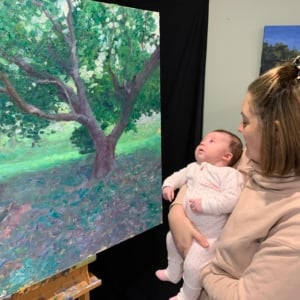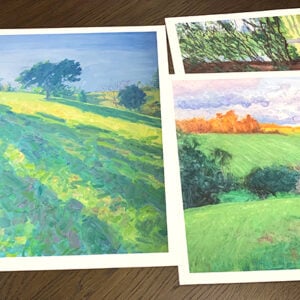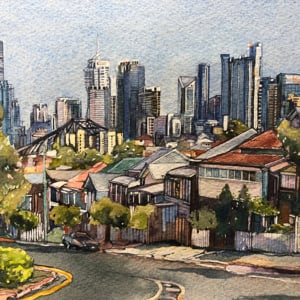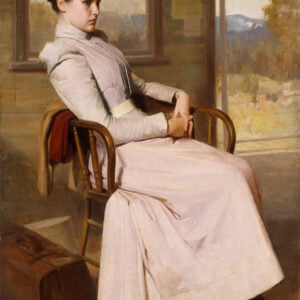Welcome to the final lesson of the Painting the Landscape workshop.
In the last lesson, I showed you how my painting turned out. I’ll title it, Maleny, White, Purple, and Blue Flowers. Now it’s time to reflect on my work.

Whenever I finish a painting, I briefly reflect on how it turned out, what went well, and what I could improve for next time. I do this in my head, but for demonstration purposes, I’ll document my thoughts in a more structured format.
My self-reflection process involves three questions:
Am I happy with the painting? This is a high-level question that summarizes my general thoughts about the painting. The answer is typically a straightforward “yes”, “no”, or “it’s OK”.
What went well? I consider what I particularly like about the painting or things that I did well during the painting process. This might include good use of technique, solving a difficult problem, fixing a mistake, or conveying the subject in a creative way.
What could be improved? Even my best paintings have aspects that could be improved. Few people could say otherwise, unless your name happens to be Joaquín Sorolla or Diego Velázquez. The challenge is correctly identifying those weak aspects. If you’re new to painting, you’ll struggle with this. You might know something is wrong with the painting but be unable to narrow down on the real issue. But it’s important to try. Start with broad categories. Does the issue relate to value, composition, edge, shape, color, drawing, etc? Then narrow it down from there.
Bonus download: Artwork Self-Critique Worksheet.
For this process to be effective, you must remove any sense of ego. This is no time to be arrogant or humble. Just say it as it is. Be objective. If you’re struggling with this, pretend your painting was done by another artist and take yourself out of the equation.
Also, be careful about comparing yourself to others. I mostly reflect on my work in relation to my previous work. I’m not looking to create the best painting in the world; I just want this painting to be a bit better than the last.
I only use comparison as a way to visualize what I’m aiming for in painting. My favorite artists represent the upper echelon of painting. They show me what’s possible and they give me something to shoot for. I may never join them or surpass them, but that’s OK. The joy is in trying and improving.
Anyway, the following is my self-reflection.
Am I Happy With the Painting?
Yes. It looks fresh and painterly, yet realistic. And most importantly, it reminds me of that overcast day in Maleny with my family.
What Went Well?
- The brushwork and colors I used for the sloping land are spot on.
- The impasto brushwork and broken color I used for the feature plant draw focus to the area and create the illusion of detail and activity.
- The trees in the background appear realistic without drawing too much attention. Not easy to do!
What Could Be Improved?
- The sky could be a touch lighter. I also could have used more variance in terms of color. The sky was an opportunity to use subtle shifts in temperature and value to create interest and depth.
- The intricate branches at the top are a bit sloppy. I should have used a finer brush and been more delicate with my technique.
- I reworked the feature plant and foreground too much. Reworking usually means I’m unsure of my next steps and I’m trying to guess my way through the painting. The less reworking I do, the better.
Exercise (Optional):
Reflect on your work. Are you happy with the painting? What went well? What could be improved? You can use the Artwork Self-Critique Worksheet.
Thanks so much for joining me in this workshop! Hope you learned something new. I’ll send you an email tomorrow to wrap things up.
Let me know your thoughts in the comment section below. And if you end up painting from my reference photo, send us a photo to admin@drawpaintacademy.com. I’d love to see how it turns out.
Thanks!

Dan Scott
Draw Paint Academy
PS. If you want to invite any friends to the workshop, copy and paste the following link:
https://drawpaintacademy.com/free-art-tools/painting-the-landscape/







Thanks Dan…great helps!
Reworking is my biggest trap!
I thought that the painting went very well and looked just how you expected it to be. The white flowers coupled with the blues were very impressive. The background trees were also very good and I think you were being a little hard on yourself for saying you could have used a finer brush. Of course you could, but would it have made a substantial difference? I don’t think so.
A very impressive summary of what went on in the painting.
I enjoyed reading about your process and will be using some of your advice going forward while working on my own paintings. I work in watercolour, but find many of your suggestions are applicable in this medium also.
Thank you for providing a succinct guide to approaching and completing a painting!
Your lessons resonate with my ideas of expression in my paintings. Thank you.
Good morning from Montana on New Years Eve. I am working from your reference photo and I used your drawing and block in as my guides. Must be honest and say I’m painting on Arches oil paper as I was pretty sure this wasn’t going to turn out well. It’s a difficult topic. Wondering how my flowers will turn out!! But I’m having fun and I haven’t had fun painting for awhile!!! So I am keeping on following your reference photo and trying to keep my painting loose.
Your painting is lovely. Even though you said it was an overcast day I love the sense of light on the shrubs and the grass. And the tree trunks are so impressive. As are your brush strokes. Thank you!!
I agree it is very well done as it has the feeling of an overcast day. The flopwers on the bushe reflect that feeling.
Hi Dan-
I love painting what you are and observe what we found important in the reference photo. Living in the Rockies of the USA, I paint most mountains. It is challenging sometimes to paint the landscape from other countries. I am learning a lot from your lessons.
Thank you.
Thank you for these lessons! I say overall this painting was a success. The foreground plant doesn’t feel too overworked and the sky color is fine. I think what might be catching your attention is the background trees. The marks used to describe the trees are all too similar and moving in the same direction. If they were more broken up and random, would it change the whole painting? Perhaps.
Cheers from Kansas in 🇺🇸 and Happy New year!
Hi Dan,
I love the freedom and movement within your painting,…Melaney, White, Purple and Blue Flowers. The richness of colors and sheer delight of the forefront bush is absolutely charming. Quite a joy to see your results. I understand your need for accuracy of having used tinier brushes or sky color difference. I, too, have those needs of detail specificity. My seeing your superb results without the adjustments you would have preferred is a lesson for me of letting go.
Curious though, why didn’t you go back into the painting and adjust your realizations?
THANK YOU for all the clarity in your emails, so precise and heartfelt.
Marilyn
Many thanks Dan for your information and process in drawing and Painting landscapes. The questions throughout are really helpful and act as a reminder to check things like values, colour temperature etc.
I love it painting! I’m partial to small blue flowers. I am learning a lot from you.I want to try the broken color strokes u do. I am way to critical of my paintings. U taught me a lot from the self evaluation section.
Sorry meant I love your painting it’s so beautiful.
Hi Dan,
When I first looked at your reference photo, I did not expect the result that you have achieved. Choosing and experiencing the scene and taking the photo yourself make all the difference. The viewer won’t know that you reworked the bush several times – with time you might forget this too. I love your use of colour and impasto.
Thank you again for your summary. Very helpful and hope to take them on board with my paintings. Jean
Thank you for your very helpful lessons. Would you explain what exactly is meant by “broken color”.
Thanks for a helpful series of lessons – I love your style -I think your reflections pretty accurate….what impressed me most was your interpretation of the photo – and the way you made a boring flat area of grass look lively and full of colour and shadow…..I hope to use this in a painting of one of my own photos –
Thank you for sharing so much, Dan. I love this painting. I feel a lovely sense of movement and a breeze in the trees.Your colours are so rich and vibrant.In South Carolina we planted a small shrub named Yesterday, Today and Tomorrow which blooms in April here..white, lavender and a dark purple…exquisite.I wonder if it is a relative of your plant😀
Happy and healthy New Year!
Thanks, Dan.
I am an admirer of your painting technique, although I struggle with my own and can’t seem to loosen up with broken colour, the way you do.
Your “Maleny” painting is simply exquisite and your analysis of it was helpful, but I would disagree with your estimation that the background trees needed a finer brush. They have just the right look to offset the foreground flowers and the bright greens. Well done!
I have to admit that I did read your sky as a grey rock face, which also works well for me.
I live in Ontario, Canada and really enjoy landscape. Thank you for what you do with the Draw Paint Academy and your sharing.
Hi Dan,
Happy New year to you and Family.
I have to admit I hated the ref. photo. I don’t believe I would have chosen to paint it. But.. you did a great job with it.
I agree the background trees are a bit of a problem for me.
I enjoyed this exercise, and you motivated me to work step by step. I appreciate your thoughtful comments, and I am now doing my own reflection of my work.
Your painting reflects your style, choice of colour. I feel it is your interpretation, and I don’t have suggestions as such. I like the spontaneous brush work, the energy.
Hope we can all do this again,
Happy New Year from Vancouver Island, BC
Thank you so much again for your guidance and comments and your reflections, and the time you must have spent putting this workshop together. I love your paintings and your style, including this one. I use watercolor (started about 2 years ago), but so many of your ideas are applicable, and you inspire me – and probably all of us- to keep trying and to enjoy the process. I will be in NSW again soon, and I will try to take reference photos I can use, but it will be a new challenge. The wide ocean views, the landscape, the national parks, trees and vegetation are so overwhelmingly beautiful at times and so different from where I live in the U.S. Thanks again!
Thank you for my first painting with you. I love doing he bare branches and liked how the original picture the trees lead your eye around the picture. I overworked my painting and amenspired to do it again. I love your comments.
Thanks Dan. I intentionally didn’t look at you finished painting until I had reached almost the end of my painting, so that I could truly see the difference in styles. I normally start out doors, find an image that excites me with a focus that calls to me. I take a photo because I hardly ever finish on site. Photos never capture what drew my attention, but do remind me of the scene. Living in BC Canada, the trees and angle of the sun are so different, also we are heading into winter so the light and colours are very different than what you are experiencing. So I painted somewhat what I see here as that is what I am familiar with. I wanted my foreground to pop out against the back ground and while I didn’t achieve it was a good exercise. I enjoyed you captured that in your painting, and I liked the use of mauve in background and your shading of the flowers. Your painting captured the photo very well. I love the subtle diffused lighting and soft feeling of the painting. I would enjoy working with my own photos and seeing how others do the same. Thank you for your guidance.
Ps I will send my picture but can’t find the email that you gave.
Thank you Dan, I am learning so much from you. Your ‘Maleny… ‘ is probably now my favourite from all of yours I have seen – I’m looking forward to attempting it – what I found most illuminating was watching the videos, both normal time and time lapse, it has helped in the way I approach my own painting. Once again- thank you so much.
Dear Dan, I especially want to thank you f or this series. You have put into words and visuals what I’ve been trying to convey to my own students about the painting process. You’ve given me an excellent structure to share that info crediting you. Your generosity is wonderful. Thank you. Sheila Parsons. Sparsons.com
Thank you, Dan for the workshop. After the second lesson, I tried to start my own version of the painting, and after analyzing the photo, I made the first sketch.
The first difficulty I had was with small blue flowers, because in the reference photo I have all the flowers are purple. It’s good that you said about of the small blue flowers. As a photographer, I know that blue and purple are tricky when shooting.
After the third lesson, your version of the painting appeared. I was impressed, but did not consider it for a long time, so as not to depend on your vision.
A bit later I watched your tutorial on Painting a Tree Series, Bright Greens (Long). I discovered your patience and that you use a small brush. I am a patient person, but not so much. Your painting with a group of trees made a huge impression on me. After that, I began to more patiently paint my picture.
Today, when I finished my version after suffering enough, I opened your version!
I was blown away by your painting, by your addition of light to the left. It changed the whole painting at once. The whole composition became integral. Amazing!
I’m not sure that I would have been able to fully appreciate your painting if I had not tormented myself first with my version.
What I like about my job.
1. that I accepted this challenge. This was a big test for me.
2. I gained a lot of experience during drawing in terms of the order of drawing, the play of light and shadow, in drawing the sky.
What could be done better.
1. Adding the light to the composition. It would change the painting completely for the better.
2. Maybe I’ll try to fix it. But I will be guided not by your painting, but by the impression how I saw it.
I disagree about the plant in the foreground. I think it really comes out of the canvas like 3-D!
Hi Dan,
Great work, I liked the painting. I agree about your comments concerning the sky and the branches at the top.
I also liked the workshop and wish more to follow.
Happy new year!
Dan, All your lessons have given me valuable information that I wish I’d had 30 years ago when I started painting. I have had new motivation and renewed energy to keep going as I get a lot of pleasure and enjoy working on problems especially when the end result is an ah ah. I am living in New Zealand and the light here is intense – good to get out either early in the morning or late afternoon but I mostly work in studio (garage). The world opens up so thank you for providing names of other earlier artists who probably also had challenges to overcome. All the best for a lot of wonderful paintings in 2023.
Dan,
I like the idea of you posting another Photo and seeing how everyone interprets it.
I am trying to get back to painting and the small lessons are helping to help me to focus a little at time. Grandson want images from vacation so I trying. Help.
Dan thank you for this great workshop. How can I send you a copy of my finished painting?
Hi Linda – just email it in to us at admin@drawpaintacademy.com
This could be the missing puzzle piece for me. I journal about what happens in the studio but have never sat down to assess a painting like this. TBH, that is usually because no painting is ever finished (I am working on that too!) but I think self reflection could be an additional tool in the never ending journey to improve 😉
Thanks Dan!
Thank you very much, Dan. I have learned so much from you. Appreciate your knowledge
& experience of art, & the way it’s demonstrated & explained.